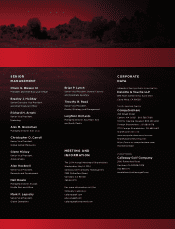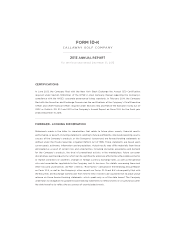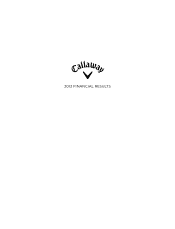Callaway 2013 Annual Report Download - page 16
Download and view the complete annual report
Please find page 16 of the 2013 Callaway annual report below. You can navigate through the pages in the report by either clicking on the pages listed below, or by using the keyword search tool below to find specific information within the annual report.2
combination of metal and a composite material. The Company’s products compete at various price levels in the woods
category. The Company’s drivers, fairway woods and hybrid products are available in a variety of lofts, shafts and other
specifications to accommodate the preferences and skill levels of all golfers.
Irons. This product category includes sales of the Company’s irons and wedges, which are sold under the Callaway
Golf brand. The Company’s irons are generally made of metal (either titanium, steel or special alloy) or a composite
material (a combination of metal and polymer materials). The Company’s products compete at various price levels in the
irons category. The Company’s irons are available in a variety of designs, shafts and other specifications to accommodate
the preferences and skill levels of all golfers.
Putters. This product category includes sales of the Company’s putters, which are sold under the Odyssey brand.
The Company’s products compete at multiple price levels in the putters category. The Company’s putters are available
in a variety of styles, shafts and other specifications to accommodate the preferences and skill levels of all golfers.
Golf Balls. This product category includes sales of the Company’s golf balls, which are sold under the Callaway
Golf and Strata brands. The Company’s golf balls are generally either a 2-piece golf ball (consisting of a core and cover)
or a multilayer golf ball (consisting of two or more components in addition to the cover). The Company’s golf ball products
include covers that incorporate a traditional dimple pattern as well as covers that incorporate innovative designs, including
the Company’s proprietary HEX Aerodynamics (i.e., a lattice of tubes that form hexagons and pentagons). The Company’s
products compete at all price levels in the golf ball category.
Accessories and Other. This product category includes sales of packaged sets, golf bags, golf gloves, golf footwear,
golf apparel, travel gear, headwear, towels, umbrellas, eyewear and other accessories, as well as sales of pre-owned
products through the Company's website, www.callawaygolfpreowned.com. Additionally, this product category includes
royalties from licensing of the Company’s trademarks and service marks on products including golf apparel and footwear,
golf gloves, umbrellas, prescription eyewear, and practice aids.
Product Design and Development
Product design at the Company is a result of the integrated efforts of its brand management, research and development,
manufacturing and sales departments, all of which work together to generate new ideas for golf equipment. The Company
has not limited itself in its research efforts by trying to duplicate designs that are traditional or conventional and believes
it has created a work environment in which new ideas are valued and explored. In 2013, 2012 and 2011, the Company
invested $30.9 million, $29.5 million, and $34.3 million, respectively, in research and development. The Company intends
to continue to invest substantial amounts in its research and development activities in connection with its development
of new products.
The Company has the ability to create and modify product designs by using computer aided design (“CAD”) software,
computer aided manufacturing (“CAM”) software and computer numerical control milling equipment. CAD software
enables designers to develop computer models of new product designs. CAM software is then used by engineers to
translate the digital output from CAD computer models so that physical prototypes can be produced. Further, the Company
utilizes a variety of testing equipment and computer software, including golf robots, launch monitors, a proprietary virtual
test center, a proprietary performance analysis system, an indoor test range and other methods to develop and test its
products. Through the use of these technologies, the Company has been able to accelerate and make more efficient the
design, development and testing of new golf clubs and golf balls.
For certain risks associated with product design and development, see below, “Risk Factors” contained in Item 1A.
Manufacturing
The Company has its primary golf club assembly facility in Monterrey, Mexico, and maintains limited golf club
assembly for certain custom club orders in its facilities in Carlsbad, California. Golf clubs are also assembled in China,
Japan and other local markets based on regional demand for custom clubs. At December 31, 2013 and 2012, most of
the Company’s golf club production volume was made in regions outside of the United States. Overall, the golf club
assembly process is fairly labor intensive and requires extensive global supply chain coordination and utilizes raw materials
that are obtained from suppliers both internationally and within the United States.
























